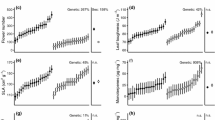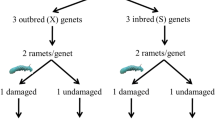Abstract
The search for general patterns in the production and allocation of plant defense traits will be facilitated by characterizing multivariate suites of defense, as well as by studying additional plant taxa, particularly those with available genomic resources. Here, we investigated patterns of genetic variation in phytochemical defenses (phenylpropanoid glycosides, PPGs) in Mimulus guttatus (yellow monkeyflower). We grew plants derived from several natural populations, consisting of multiple full-sibling families within each population, in a common greenhouse environment. We found substantial variation in the constitutive multivariate PPG phenotype and in constitutive levels of individual phytochemicals within plants (among leaves of different ages), within populations (among full-sibling families), and among populations. Populations consisting of annual plants generally, but not always, had lower concentrations of phytochemicals than did populations of perennial plants. Populations differed in their plastic response to artificial herbivory, both in the overall multivariate PPG phenotype and in the individual phytochemicals. The relationship between phytochemistry and another defense trait, trichomes, differed among populations. Finally, we demonstrated that one of the PPGs, verbascoside, acts as a feeding stimulant rather than a feeding deterrent for a specialist herbivore of M. guttatus, the buckeye caterpillar (Junonia coenia Nymphalidae). Given its available genetic resources, numerous, easily accessible natural populations, and patterns of genetic variation highlighted in this research, M. guttatus provides an ideal model system in which to test ecological and evolutionary theories of plant-herbivore interactions.







Similar content being viewed by others
References
Adler, L. S., Schmitt, J., and Bowers, M. D. 1995. Genetic variation in defensive chemistry in Plantago lanceolata (Plantaginaceae) and its effect on the specialist herbivore Junonia coenia (Nymphalidae). Oecologia 101:75–85.
Agrawal, A. A. and Fishbein, M. 2006. Plant defense syndromes. Ecology 87:S132–S149.
Agrawal, A. A., Salminen, J.-H., and Fishbein, M. 2009. Phylogenetic trends in phenolic metabolism of milkweeds (Asclepias): evidence for escalation. Evolution 63:663–673.
Ali, J. G. and Agrawal, A. A. 2012. Specialist versus generalist insect herbivores and plant defense. Trends Plant Sci. 17:293–302.
Anderson, J. T. and Mitchell-Olds, T. 2011. Ecological genetics and genomics of plant defenses: evidence and approaches. Funct. Ecol. 25:312–324.
Barton, K. E. and Koricheva, J. 2010. The ontogeny of plant defense and herbivory: characterizing general patterns using meta-analysis. Am. Nat. 175:481–493.
Beardsley, P. M. and Olmstead, R. G. 2002. Redefining Phrymaceae: the placement of Mimulus, tribe Mimuleae, and Phryma. Am. J. Bot. 89:1093–1102.
Becerra, J. X., Noge, K., and Venable, D. L. 2009. Macroevolutionary chemical escalation in an ancient plant-herbivore arms race. Proc. Natl. Acad. Sci. U. S. A. 106:18062–18066.
Berenbaum, M. R. and Zangerl, A. 2008. Facing the future of plant-insect interaction research: Le retour a` la “raison d'être.”. Plant Physiol. 146:804–811.
Boege, K. and Marquis, R. J. 2005. Facing herbivory as you grow up: the ontogeny of resistance in plants. Trends Ecol. Evol. 20:441–448.
Bowers, M. D. 1984. Iridoid glycosides and host-plant specificity in larvae of the buckeye butterfly, Junonia coenia (Nymphalidae). J. Chem. Ecol. 10:1567–1577.
Bowers, M. D. and Puttick, G. M. 1988. Response of generalist and specialist insects to qualitative allelochemical variation. J. Chem. Ecol. 14:319–334.
Camara, M. D. 1997. Predator responses to sequestered plant toxins in buckeye caterpillars: are tritrophic interactions locally variable? J. Chem. Ecol. 23:2093–2106.
Carmona, D., Lajeunesse, M. J., and Johnson, M. T. J. 2011. Plant traits that predict resistance to herbivores. Funct. Ecol. 25:358–357.
Carr, D. E. and Eubanks, M. D. 2002. Inbreeding alters resistance to insect herbivory and host plant quality in Mimulus guttatus (Schrophulariaceae). Evolution 56:22–30.
Carroll, M. J., Zangerl, A. R., and Berenbaum, M. R. 2000. Heritability estimates for octyl acetate and octyl butyrate in the mature fruit of the wild parsnip. J. Hered. 91:68–71.
Clauss, M. J., Dietel, S., Schubert, G., and Mitchell-Olds, T. 2006. Glucosinolate and trichome defenses in a natural Arabidopsis lyrata population. J. Chem. Ecol. 32:2351–2373.
Diezel, C., Ailmann, S., and Baldwin, I. T. 2011. Mechanisms of optimal defense patterns in Nicotiana attenuate: flowering attenuates herbivory-elicted ethylene and jasmonate signaling. J. Int. Plant Biol. 53:971–983.
Falconer, D. F. and Mackay, T. F. C. 1996. Introduction to Quantitative Genetics, 4th ed. Longman Group Ltd, England.
Fenster, C. B. and Ritland, K. 1994. Quantitative genetics of mating system divergence in the yellow monkeyflower species complex. Heredity 73:422–435.
Franzyk, H., Husum, T. L., and Jensen, S. R. 1998. A caffeoyl phenylethanoid glycoside from Plantago myosuros. Phytochemistry 47:1161–1162.
Geber, M. A. and Griffen, L. R. 2003. Inheritance and natural selection on functional traits. Int. J. Plant Sci. 164:S21–S42.
Hakes, A. S. and Cronin, J. T. 2011. Resistance and tolerance to herbivory in Solidago altissima (Asteraceae): genetic variability, costs, and selection for multiple traits. Am. J. Bot. 98:1445–1455.
Hall, M. C. and Willis, J. H. 2006. Divergent selection on flowering time contributes to local adaptation in Mimulus guttatus populations. Evolution 60:2466–2477.
Harborne, J. B. 1993. Introduction to Ecological Biochemistry, 4th ed. Academic, London.
Hegnauer, R. and Kooiman, P. 1978. Taxonomic significance of iridoids of Tubiflorae sensu Wettstein. Planta Med. 33:1–33.
Hjältén, J. 2004. Simulating herbivory: problems and possibilities, pp. 243–255, in W. W. Weisser and E. Siemann (eds.), Ecological Studies-Analysis and Synthesis, Vol. 173. Springer-Verlag Press, Berlin.
Holeski, L. M. 2007. Within and between generation variation in trichome density of Mimulus guttatus. J. Evol. Biol. 20:2092–2100.
Holeski, L. M., Chase-alone, R., and Kelly, J. K. 2010. The genetics of phenotypic plasticity in plant defense: trichome production in Mimulus guttatus. Am. Nat. 175:391–400.
Ivey, C. T., Carr, D. E., and Eubanks, M. D. 2009. Genetic variation and constraints on the evolution of defense against spittlebug (Philaenus spumarius) herbivory in Mimulus guttatus. Heredity 102:303–311.
Kelly, J. K. and Arathi, H. S. 2003. Inbreeding and the genetic variance in floral traits of Mimulus guttatus. Heredity 90:77–83.
Koricheva, J. 1999. Interpreting phenotypic variation in plant allelochemistry: problems with the use of concentrations. Oecologia 119:467–473.
Kruskal, J. B. 1964. Multidimensional scaling by optimizing goodness of fit to a nonmetric hypothesis. Psychometrika 29:1–26.
Kursar, T. A. and Coley, P. D. 2003. Convergence in defense syndromes of young leaves in tropical rainforests. Biochem. Syst. Ecol. 8:929–949.
Lekberg, Y., Roskilly, B., Hendrick, M. F., Zabinkski, C. A., Barr, C. M., and Fishman, L. 2012. Phenotypic and genetic differentiation among yellow monkeyflower populations from thermal and non-thermal soils in Yellowstone National Park. Oecologia 170:111–122.
Levine, J. M. 1999. Indirect facilitation: evidence and predictions from a riparian community. Ecology 80:1762–1769.
Levine, J. M. 2000. Local interactions, dispersal, and native and exotic plant diversity along a California stream. Oikos 95:397–408.
Mitchell-Olds, T. 2001. Arabidopsis thaliana and its wild relatives: a model system for ecology and evolution. Trends Ecol. Evol. 16:693–700.
Mølgaard, P. 1986. Population genetics and geographical distribution of caffeic acid esters in leaves of Plantago major in Denmark. J. Ecol. 74:1127–1137.
Mølgaard, P. and Ravn, H. 1988. Evolutionary aspects of caffeoyl ester distribution in dicotyledons. Phytochemistry 27:2411–2421.
Mousseau, T. A. and ROFF, D. A. 1987. Natural selection and the heritability of fitness components. Heredity 59:181–197.
Rausher, M. D. 1996. Genetic analysis of coevolution between plants and their natural enemies. Trends Genet. 12:212–217.
Reymond, P., Bodenhausen, N., van Poecke, R. M. P., Krisnamurthy, V., Dicke, M., and Farmer, E. E. 2004. A conserved transcript pattern in response to a specialist and a generalist herbivore. Plant Cell 16:3132–3147.
Schenk, P. M., Kazan, K., Wilson, I., Anderson, J. P., Richmond, T., Somerville, S. C., and Manners, J. M. 2000. Coordinated plant defense responses in Arabidopsis revealed by microarray analysis. Proc. Natl. Acad. Sci. U. S. A. 97:11655–11660.
Stamp, N. 2003. Out of the quagmire of plant defense hypotheses. Quant. Rev. Biol. 78:23–55.
Stotz, H. U., Kroymann, J., and Mitchell-Olds, T. 1999. Plant-insect interactions. Curr. Opin. Plant Biol. 2:268–272.
Tian, D., Peiffer, M., Shoemaker, E., Tooker, J., Haubruge, E., Francis, F., Luthe, D. S., and Felton, D. W. 2012. Salivary glucose oxidase from caterpillars mediates the induction of rapid and delayed-induced defenses in the tomato plant. PLoS One 7:e36168.
van der Meijden, E., Wijn, M., and Verkaar, H. J. 1988. Defense and regrowth: alternative plant strategies in the struggle against herbivores. Oikos 51:355–363.
van der Putten, W. H. 2003. Plant defense belowground and spatiotemporal processes in natural vegetation. Ecology 84:2269–2280.
Wu, C. A., Lowry, D. B., Cooley, A. M., Wright, K. M., Lee, Y. W., and Willis, J. H. 2008. Mimulus is an emerging model system for the integration of ecological and genomic studies. Heredity 100:220–230.
Acknowledgments
The authors thank the Mimulus seed library (Duke University) and D. Lowry who generously provided some of the seeds used in this study. Thanks to E. Lewis and M. Crossley for help with sample processing and M. Arntz and R. Ecker for laboratory assistance. We are grateful for comments by several anonymous reviewers and J. Couture that substantially improved this manuscript. Z. HarnEnz was funded through the IBS-SRP (Integrated Biological Sciences Summer Research Program) at the University of Wisconsin, Madison. This work was supported in part by the National Science Foundation (grant numbers FIBR-0425908, DEB-0841609).
Author information
Authors and Affiliations
Corresponding author
Rights and permissions
About this article
Cite this article
Holeski, L.M., Keefover-Ring, K., Bowers, M.D. et al. Patterns of Phytochemical Variation in Mimulus guttatus (Yellow Monkeyflower). J Chem Ecol 39, 525–536 (2013). https://doi.org/10.1007/s10886-013-0270-7
Received:
Revised:
Accepted:
Published:
Issue Date:
DOI: https://doi.org/10.1007/s10886-013-0270-7




